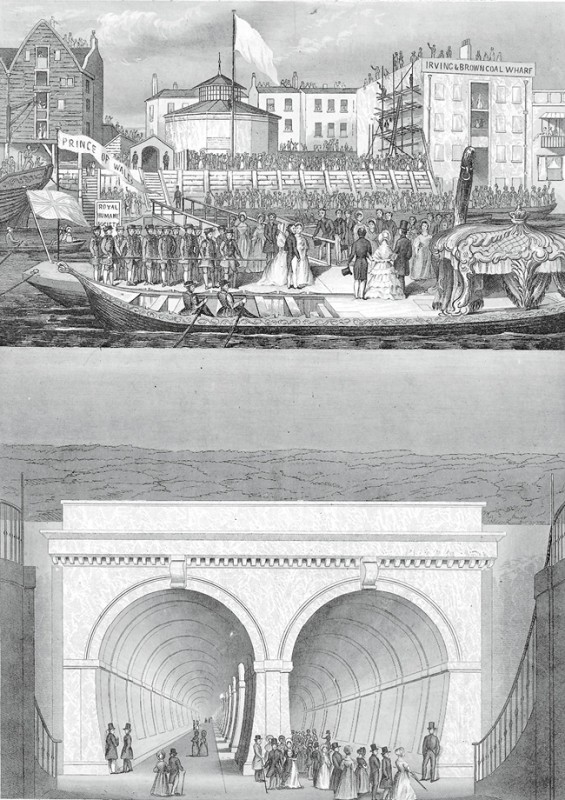
Inkwell, probably London, England, ca. 1843. Salt-glazed stoneware. L. 3 1/8". (Collection of the author; photo, John Ault.) The face of the molded inkwell is relief-decorated with a depiction of Marc Isambard Brunel’s tunneling shield, taken from the print source illustrated in fig. 12.

The reverse of the inkwell illustrated in fig. 1, with opposing simple impressed scrollwork. (Photo, John Ault.)

Top view of the inkwell illustrated in fig. 1, with a pair of foliate scrolls flanking a central aperture with two smaller apertures.

Advertising token, William Griffin, London, England, ca. 1843. Gilt brass. D. 5/16". (Photos, courtesy of the author.) Issued for the opening of the Thames Tunnel, this token features an engraving of two tunnels side by side with the words “thames tunnel / opened 1843” and, on the reverse, “THAMES TUNNEL / AND / OTHER / MEDALS / TO BE HAD OF THE / PUBLISHER / W. GRIFFIN / 25 / CHANGE ALLEY / CORNHILL LONDON.”

Plate, probably Staffordshire, England, ca. 1843. Lead-glazed earthenware. D. 6". (Private collection; photo, Robert Hunter.) Various sizes and colors of this souvenir plate design were -produced. This example has a molded border of roses and tulips. Small mugs printed in black, blue, and green were also made and sold.

Detail of the transfer print on the plate illustrated in fig. 5. The interior transfer print derived from one of the many period engravings of the tunnel’s opening in 1843. It is inscribed THAMES TUNNEL. / 1200 feet long, 76 feet below high water mark, was 8 years building / & cost £446.000. Opened the 25th day of March.1843.”

Engraving, London, England, ca. 1843. Porcelain card. 10 x 7U÷*". (Private collection.) Inscribed: “T. Brandon delineavit - Engraver, Printer, Publisher, 41 Thames Tunnel. London, 1843.” The upper view is labeled “Commemorative of the Visit of Her Most Gracious Majesty / QUEEN VICTORIA and HER LOYAL CONSORT / accompanied by other Illustrious & Distinguished Personages / on Wednesday, 26 July 1843.” The lower view is labeled “THAMES TUNNEL. /WAPPING ENTRANCE / 1200 feet long 76 feet below high water mark, was 8 Years building and cost £446.000 Opened March 25, 1843.” These so-called porcelain cards were printed on only one side of a piece of thick paper with a shiny coating and used around the middle of the nineteenth century, often as business cards. Although predominantly manufactured in Belgium, they were made in Britain and Germany as well.

Robert Howlett (British, 1831–1858), Isambard Kingdom Brunel Standing before the Launching Chains of the Great Eastern, 1857, printed 1863–64. Albumen silver print from glass negative. 11 x 8 7/16". (Metropolitan Museum of Art, Gilman Collection, Purchase, Harriette and Noel Levine Gift, 2005.) Isambard Kingdom Brunel worked on the Thames Tunnel with his father, Sir Marc Isambard Brunel.

James Northcote (British, 1746–1831), Sir Marc Isambard Brunel, 1812–1813. Oil on canvas. 49 1/2 x 39". (National Portrait Gallery, London.)

Engraving, “A longitudinal section of about 40 feet of the tunnel. . . . ,” from An Explanation of the Works of the Tunnel Under the Thames from Rotherhithe to Wapping, Thames Tunnel Company, London, 1836. (New York Public Library Digital Collections. Accessed May 17, 2021. https://digitalcollections.nypl.org/items/510d47dd-fd14-a3d9-e040-e00a18064a9.)This image is a side view of the tunneling shield used both to construct the Thames Tunnel and to facilitate the building of the tunnel’s brick walls.

Engraving, “This transverse section of the Thames, with a longitudinal section of the Tunnel beneath it. . . .”, from An Explanation of the Works of the Tunnel Under the Thames from Rotherhithe to Wapping, Thames Tunnel Company, London, 1836. (New York Public Library Digital Collections. Accessed May 17, 2021. https://digitalcollections.nypl.org/items/510d47dd-fd16-a3d9-e040-e00a18064a99.) This image is a side view of the tunneling shield used both to construct the Thames Tunnel and to facilitate the building of the tunnel’s brick walls.

Engraving, “This view exhibits the workmen in the iron shield. . . .”, from An Explanation of the Works of the Tunnel Under the Thames from Rotherhithe to Wapping, Thames Tunnel Company, London, 1836. (New York Public Library Digital Collections. Accessed May 17, 2021. https://digitalcollections.nypl.org/items/510d47dd-fd13-a3d9-e040-e00a18064a99.) This view shows the cells of the tunneling shield.

Clarkson Stanfield (English, 1793–1867), “The Diving Bell, Longman & Co., J. & A. Arch & G. Cooke, London [1834].” Etching and line engraving on paper. 6 1/2 x 8 7/8". Caption: “THE DIVING BELL / Used at the THAMES TUNNEL after the Irruption of the Water on the 18th of May. 1827. ROTHERHTHE church in the distance.” (Private collection.)

Attributed to George Jones (British, 1786–1869), Banquet in the Thames Tunnel, ca. 1827. Oil on board. 37 1/2 x 32 1/2". (Ironbridge Gorge Museum Trust.)
